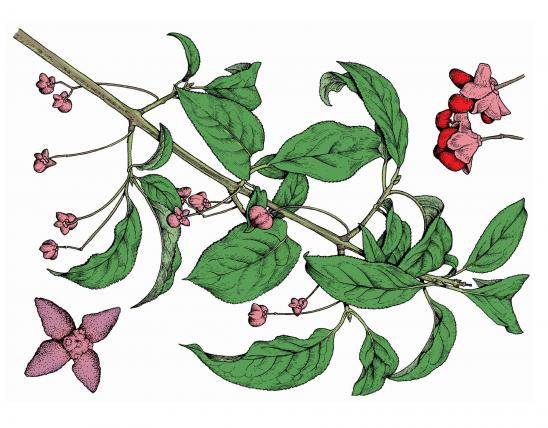
American bittersweet is a native, twining woody vine that climbs into trees to heights of 20 feet or, more commonly, sprawls on bushes or fences. Its clusters of orange fruits split into sections to reveal seeds covered with a bright red, fleshy coating.
Leaves are alternate, simple, with the blade 2–4 inches long, 1–2 inches wide, egg-shaped to oval to lance-shaped, tip pointed, the base ending at a sharp angle or rounded, the margin entire or with small, finely pointed teeth; the upper surface is dark yellowish green, smooth; the lower surface is paler, smooth; the leaf stalk is about ½ inch long, smooth.
Stems are spreading to twining, green to gray or brown; tendrils absent.
Bark is light brown, smooth, with prominent pores; the bark of old stems peels into thin flakes and small sheets; the wood is soft, porous, white.
Flowers May–June, in clusters of numerous flowers at the end of twigs; male and female flowers are in separate clusters; plants usually with mostly female or male flowers only.
- The male flowers are in clusters about 2 inches long; the flower stalks are about 1 inch long; flowers are small, inconspicuous, greenish white to yellow; petals 5; stamens 5, shorter than the petals.
- The female flowers are in clusters 1–1½ inches long; the flower stalks are 1¼–2 inches long; flowers are small, 5–25, greenish white to yellow; petals 5; stamens 5, poorly developed.
Fruits in July–October, in hanging clusters 2½–4 inches long; fruits 6–20, globe-shaped, about ¼ inch across, fruit orange to yellow, leathery, splitting into 3 sections, each section with 1 or 2 globe-shaped seeds; seeds covered with a bright red, fleshy coating, persistent and showy in autumn; seeds white at first, then cream-colored and drying to brown, oval, about ¼ inch long.
Similar species: Round-leaved bittersweet, or Asiatic or oriental bittersweet (C. orbiculatus), is closely related but is native to Asia and can aggressively escape from cultivation. It is fast becoming a serious weed in the eastern United States. Its fruits are not as showy as our native American bittersweet; prior to splitting open, the fruits are orange-yellow to orange (not orange to red) and are single or in smaller clusters. Its leaves are fairly circular (about as wide as they are long) or are broadest above (not below) the middle. Leaf margins have small, rounded (not finely pointed) teeth. Flower/fruits are axillary (arising along the stems in the leaf axils), in clusters of 2–4.
Other plants in the same family (sharing the same basic fruit structure) include our native eastern wahoo, strawberry bush, and running strawberry bush, and the nonnative invasive burning bush (winged euonymus) and wintercreeper.
Height: climbing to 20 feet.
Statewide.
Habitat and Conservation
Occurs in woodlands, rocky slopes, along bluffs, borders of glades, thickets and along fence rows. This vine spreads when birds distribute the seed, or when root suckers form large colonies on favorable sites.
Status
Native woody vine.
Human Connections
The fruit of American bittersweet is persistent and ornamental in winter because of the scarlet seed coating. It sometimes is used for indoor floral decorations, including native-plant-themed holiday wreaths.
Unfortunately, overcollection of bittersweet branches from the wild has reduced populations of this plant in some places.
American bittersweet has been in cultivation since 1736, and is used for covering trellis work, trees, rocks, and walls. The twining habit of the strong vines may be loose around small trees, but it may form tight constrictions as the tree’s diameter increases. It needs full sun for abundant flowers and fruits. Also, as with hollies, the female plants need a male plant nearby in order to produce fruits.
The fruits are reported to be poisonous if ingested, but no detailed cases of human poisoning have been reported in this country.
Historically, the bark of the root was taken internally to induce vomiting, to quiet disturbed people, to treat venereal diseases, and to increase urine flow. As an ointment mixed with grease it was used to treat skin cancers, tumors, burns, and swellings.
American bittersweet got its name when English colonists likened it to a (sort of) similar-looking vine they had known in the Old World, the common nightshade (Solanum dulcamara), which they had called bittersweet.
Ecosystem Connections
American bittersweet is the only species of Celastrus native to North America.
Bittersweet fruits are eaten by eastern cottontails and fox squirrels, and by at least 15 species of birds, including wild turkey, ruffed grouse, and northern bobwhite. Rabbits and deer browse the leaves and stems.
Bees are probably the major pollinators, although wind pollination also may occur.
A wide variety of native bees, ants, wasps, and beetles visit the flowers for pollen, nectar, or both. A geometrid moth called the common tan wave (Pleuroprucha insularia) uses bittersweet as one of its larval food plants.
It is instructive to compare our native American bittersweet with the nonnative round-leaved/Asiatic/oriental bittersweet. The latter has proven invasive in much of the eastern United States, spreading rampantly, climbing, girdling the trunks of, and blocking sunlight to its native host trees. In places where old fields were reverting back to forest, young trees are smothered by the nonnative bittersweet and are killed, so that only other aliens, such as multiflora rose and autumn olive, can survive. Perhaps worse, the nonnative bittersweet can hybridize with our native species, producing offspring that are hard to distinguish from the aggressive, nonnative species, and virtually causing our native bittersweet to practically disappear.



























